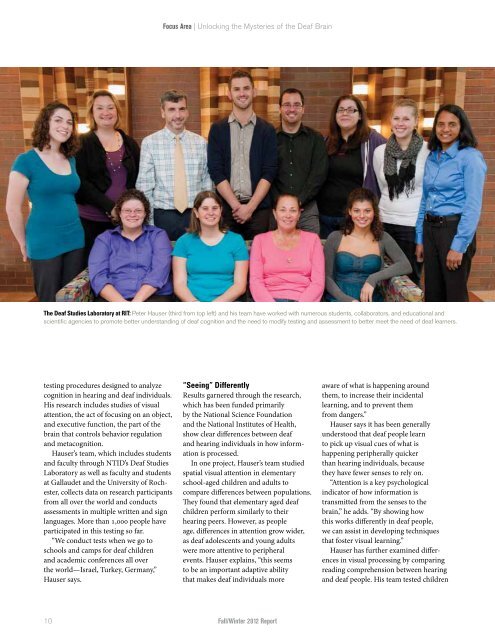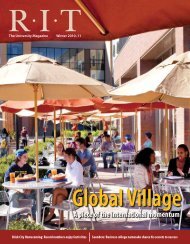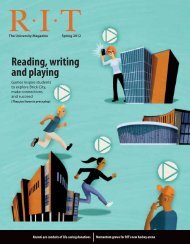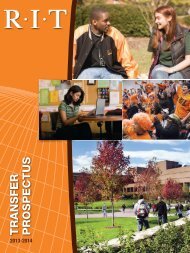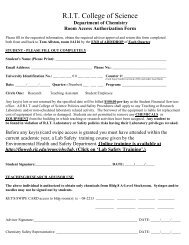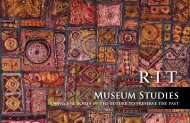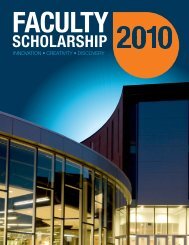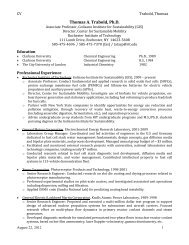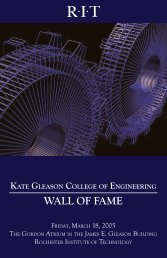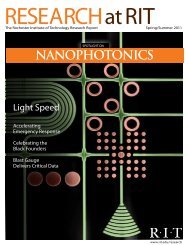Fall / Winter 2012 - Rochester Institute of Technology
Fall / Winter 2012 - Rochester Institute of Technology
Fall / Winter 2012 - Rochester Institute of Technology
Create successful ePaper yourself
Turn your PDF publications into a flip-book with our unique Google optimized e-Paper software.
Focus Area | Unlocking the Mysteries <strong>of</strong> the Deaf Brain<br />
The Deaf Studies Laboratory at RIT: Peter Hauser (third from top left) and his team have worked with numerous students, collaborators, and educational and<br />
scientific agencies to promote better understanding <strong>of</strong> deaf cognition and the need to modify testing and assessment to better meet the need <strong>of</strong> deaf learners.<br />
testing procedures designed to analyze<br />
cognition in hearing and deaf individuals.<br />
His research includes studies <strong>of</strong> visual<br />
attention, the act <strong>of</strong> focusing on an object,<br />
and executive function, the part <strong>of</strong> the<br />
brain that controls behavior regulation<br />
and metacognition.<br />
Hauser’s team, which includes students<br />
and faculty through NTID’s Deaf Studies<br />
Laboratory as well as faculty and students<br />
at Gallaudet and the University <strong>of</strong> <strong>Rochester</strong>,<br />
collects data on research participants<br />
from all over the world and conducts<br />
assessments in multiple written and sign<br />
languages. More than 1,000 people have<br />
participated in this testing so far.<br />
“We conduct tests when we go to<br />
schools and camps for deaf children<br />
and academic conferences all over<br />
the world—Israel, Turkey, Germany,”<br />
Hauser says.<br />
“Seeing” Differently<br />
Results garnered through the research,<br />
which has been funded primarily<br />
by the National Science Foundation<br />
and the National <strong>Institute</strong>s <strong>of</strong> Health,<br />
show clear differences between deaf<br />
and hearing individuals in how information<br />
is processed.<br />
In one project, Hauser’s team studied<br />
spatial visual attention in elementary<br />
school-aged children and adults to<br />
compare differences between populations.<br />
They found that elementary aged deaf<br />
children perform similarly to their<br />
hearing peers. However, as people<br />
age, differences in attention grow wider,<br />
as deaf adolescents and young adults<br />
were more attentive to peripheral<br />
events. Hauser explains, “this seems<br />
to be an important adaptive ability<br />
that makes deaf individuals more<br />
aware <strong>of</strong> what is happening around<br />
them, to increase their incidental<br />
learning, and to prevent them<br />
from dangers.”<br />
Hauser says it has been generally<br />
understood that deaf people learn<br />
to pick up visual cues <strong>of</strong> what is<br />
happening peripherally quicker<br />
than hearing individuals, because<br />
they have fewer senses to rely on.<br />
“Attention is a key psychological<br />
indicator <strong>of</strong> how information is<br />
transmitted from the senses to the<br />
brain,” he adds. “By showing how<br />
this works differently in deaf people,<br />
we can assist in developing techniques<br />
that foster visual learning.”<br />
Hauser has further examined differences<br />
in visual processing by comparing<br />
reading comprehension between hearing<br />
and deaf people. His team tested children<br />
10<br />
<strong>Fall</strong>/<strong>Winter</strong> <strong>2012</strong> Report


